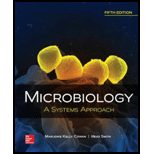
Microbiology: A Systems Approach
5th Edition
ISBN: 9781259706615
Author: Marjorie Kelly Cowan Professor
Publisher: McGraw-Hill Education
expand_more
expand_more
format_list_bulleted
Concept explainers
Question
Chapter 24, Problem 13TF
Summary Introduction
Introduction:
The atmosphere has the largest volume for nitrogen gas, followed by oxygen, and other gases account for the remaining volume. All the living organisms require nitrogen, as the genetic material and proteins contains nitrogen.
Expert Solution & Answer
Want to see the full answer?
Check out a sample textbook solution
Students have asked these similar questions
What is behavioral adapt
22. Which of the following mutant proteins is expected to have a dominant negative effect when over-
expressed in normal cells?
a. mutant PI3-kinase that lacks the SH2 domain but retains the kinase function
b. mutant Grb2 protein that cannot bind to RTK
c. mutant RTK that lacks the extracellular domain
d. mutant PDK that has the PH domain but lost the kinase function
e. all of the above
What is the label ?
Chapter 24 Solutions
Microbiology: A Systems Approach
Ch. 24.1 - Define microbial ecology.Ch. 24.1 - Summarize why our view of the abundance of...Ch. 24.1 - Prob. 3AYPCh. 24.1 - Prob. 4AYPCh. 24.1 - Prob. 5AYPCh. 24.2 - List five important elements of biogeochemical...Ch. 24.2 - Diagram a carbon cycle.Ch. 24.2 - Prob. 8AYPCh. 24.2 - Prob. 9AYPCh. 24.2 - Describe the process of nitrogen fixation, and...
Ch. 24.2 - Prob. 11AYPCh. 24.3 - Prob. 12AYPCh. 24.3 - Prob. 13AYPCh. 24.3 - Prob. 14AYPCh. 24.3 - Prob. 15AYPCh. 24.3 - Prob. 16AYPCh. 24.3 - Prob. 17AYPCh. 24.4 - Prob. 18AYPCh. 24.4 - Prob. 19AYPCh. 24 - Which of the following is not a major subdivision...Ch. 24 - Prob. 2MCQCh. 24 - Prob. 3MCQCh. 24 - Prob. 4MCQCh. 24 - Root nodules contain ______, which can ________....Ch. 24 - Prob. 6MCQCh. 24 - Prob. 7MCQCh. 24 - Prob. 8MCQCh. 24 - Prob. 9MCQCh. 24 - Recent studies reveal that a. 100% of...Ch. 24 - Prob. 11TFCh. 24 - Prob. 12TFCh. 24 - Prob. 13TFCh. 24 - A plastisphere is a specialized ball used when...Ch. 24 - Prob. 15TFCh. 24 - Prob. 1CTQCh. 24 - a. Outline the general characteristics of a...Ch. 24 - Summarize the role microbes play in the cycling of...Ch. 24 - Many people use animal manure to fertilize their...Ch. 24 - PCBs are human-made pollutants that are not...Ch. 24 - Prob. 1VCCh. 24 - From chapter 8, figure 8.24. What process does...Ch. 24 - Prob. 1CM
Knowledge Booster
Learn more about
Need a deep-dive on the concept behind this application? Look no further. Learn more about this topic, biology and related others by exploring similar questions and additional content below.Similar questions
- Can you described the image? Can you explain the question as well their answer and how to get to an answer to an problem like this?arrow_forwardglg 112 mid unit assignment Identifying melting processesarrow_forwardGive only the mode of inheritance consistent with all three pedigrees and only two reasons that support this, nothing more, (it shouldn't take too long)arrow_forward
- Oarrow_forwardDescribe the principle of homeostasis.arrow_forwardExplain how the hormones of the glands listed below travel around the body to target organs and tissues : Pituitary gland Hypothalamus Thyroid Parathyroid Adrenal Pineal Pancreas(islets of langerhans) Gonads (testes and ovaries) Placentaarrow_forward
- What are the functions of the hormones produced in the glands listed below: Pituitary gland Hypothalamus Thyroid Parathyroid Adrenal Pineal Pancreas(islets of langerhans) Gonads (testes and ovaries) Placentaarrow_forwardDescribe the hormones produced in the glands listed below: Pituitary gland Hypothalamus Thyroid Parathyroid Adrenal Pineal Pancreas(islets of langerhans) Gonads (testes and ovaries) Placentaarrow_forwardPlease help me calculate drug dosage from the following information: Patient weight: 35 pounds, so 15.9 kilograms (got this by dividing 35 pounds by 2.2 kilograms) Drug dose: 0.05mg/kg Drug concentration: 2mg/mLarrow_forward
- A 25-year-old woman presents to the emergency department with a 2-day history of fever, chills, severe headache, and confusion. She recently returned from a trip to sub-Saharan Africa, where she did not take malaria prophylaxis. On examination, she is febrile (39.8°C/103.6°F) and hypotensive. Laboratory studies reveal hemoglobin of 8.0 g/dL, platelet count of 50,000/μL, and evidence of hemoglobinuria. A peripheral blood smear shows ring forms and banana-shaped gametocytes. Which of the following Plasmodium species is most likely responsible for her severe symptoms? A. Plasmodium vivax B. Plasmodium ovale C. Plasmodium malariae D. Plasmodium falciparumarrow_forwardStandard Concentration (caffeine) mg/L Absorbance Reading 10 0.322 20 0.697 40 1.535 60 2.520 80 3.100arrow_forwardPlease draw in the missing answer, thank youarrow_forward
arrow_back_ios
SEE MORE QUESTIONS
arrow_forward_ios
Recommended textbooks for you
 Biology 2eBiologyISBN:9781947172517Author:Matthew Douglas, Jung Choi, Mary Ann ClarkPublisher:OpenStax
Biology 2eBiologyISBN:9781947172517Author:Matthew Douglas, Jung Choi, Mary Ann ClarkPublisher:OpenStax Human Physiology: From Cells to Systems (MindTap ...BiologyISBN:9781285866932Author:Lauralee SherwoodPublisher:Cengage LearningEssentials of Pharmacology for Health ProfessionsNursingISBN:9781305441620Author:WOODROWPublisher:Cengage
Human Physiology: From Cells to Systems (MindTap ...BiologyISBN:9781285866932Author:Lauralee SherwoodPublisher:Cengage LearningEssentials of Pharmacology for Health ProfessionsNursingISBN:9781305441620Author:WOODROWPublisher:Cengage

Biology 2e
Biology
ISBN:9781947172517
Author:Matthew Douglas, Jung Choi, Mary Ann Clark
Publisher:OpenStax




Human Physiology: From Cells to Systems (MindTap ...
Biology
ISBN:9781285866932
Author:Lauralee Sherwood
Publisher:Cengage Learning

Essentials of Pharmacology for Health Professions
Nursing
ISBN:9781305441620
Author:WOODROW
Publisher:Cengage
Metabolic Pathways; Author: Wisc-Online;https://www.youtube.com/watch?v=m61bQYio9ys;License: Standard Youtube License